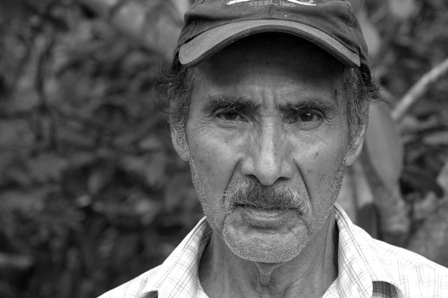
Agapito stands in a field under the glare of the noon sun in Tlaquiltenango, Morelos, taking a break to talk about his life in el campo. Behind him, men are harvesting jicama. They toss the jicama—a white, slightly sweet root vegetable—into wicker baskets, which they then hoist over their heads. Running to a nearby truck, they throw the baskets to men waiting there, and then run back to the piles of jicama. Other men grab the empty baskets from the truck and run to deliver them to the harvesters. All the while, dozens of rats dart between piles of vegetation, seeking shelter from the birds that circle overhead. The birds dive now and then, occasionally snagging a rat.
Agapito, the field’s manager, surveys the frenetic scene calmly. He has worked in el campo (Mexico’s rural farmland) all his life. Like over 80 percent of all campesinos (rural workers) he is classified by the experts as “extremely poor.” He earns, on average, two dollars a day. “There’s enough to eat when there is a lot of work,” he says. What happens when there is not enough work? He shrugs. “When there is not enough work, I eat less.”
Lately, many campesinos are eating less as Mexico’s agricultural crisis continues to worsen. Not long ago, Mexico was agriculturally self-sufficient; now it imports just over 40 percent of its food. And food has become more expensive: since 2007, the cost of Mexican staples such as beans, rice, and eggs has almost doubled. The price of tortillas rose more than 700 percent between 1994 and 2007. These increases affect all Mexicans, but hit the working poor particularly hard.
Even as their food becomes more expensive, campesinos are earning less from their crops, partly because the cost of growing those crops has increased. Items like seed and fertilizer have become much more expensive in recent years. Campesinos often supplement their meager incomes by working in nearby cities, and they have relied heavily on remittances from family members in the United States. The economic downturn has greatly reduced the number of jobs in Mexico, and remittances—ranked as the second largest source of income in Mexico—are expected to drop by as much as 20 percent this year.
Since the mid-1980s, 2 million people (about 15 percent of Mexico’s population) have abandoned rural areas and moved to towns and cities. Instituto Maya, a campesino advocacy group, refers to this as an indigenous diaspora. Many campesinos attempt to enter the United States, looking for farm work.
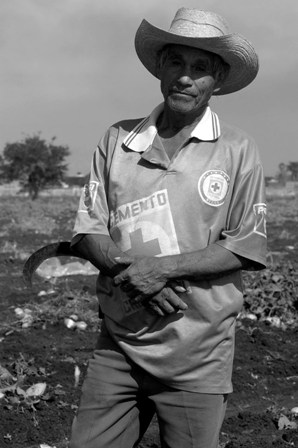
While many problems are pushing an already impoverished population deeper into destitution, the main causes of this crisis are surely the Mexican government’s agricultural policies and trade agreements, most notably the North American Free Trade Agreement (NAFTA). Both have led to a consolidation of land. As the farms have become bigger—and fewer—the power of agribusiness has increased.
The majority of land-owning campesinos have less than five acres each, and many own just over two. Almost half of all the land farmed in Mexico is organized into collectively owned properties called ejidos, an outgrowth of the agricultural reform and land redistribution that followed the Mexican Revolution. In the early 1980s, the Mexican government began instituting policies that radically affected Mexican agriculture. These policies included trade liberalization, privatization, and deregulation, all of which favored larger farms and corporations and left campesinos at an extreme disadvantage. One of the most significant policy decisions was made in 1992, when the Mexican Constitution was changed to allow the sale of land that belonged to ejidos—so that anyone, including foreign corporations, could buy it.
Then, in 1994, came NAFTA. While not all of Mexico’s agricultural problems can be blamed on NAFTA, it’s clear that the trade agreement has greatly exacerbated the difficulties faced by campesinos. NAFTA allowed for increased trade of agricultural goods and encouraged foreign investment and mechanization of Mexican farms. Although the Mexican government anticipated that NAFTA would, in effect, drive campesinos from their land, it also expected that more foreign investment would lead to an increase in nonagricultural jobs for displaced farm workers. But there were never enough jobs in the city to absorb the influx of newly unemployed workers from rural areas. Economists and politicians also believed that NAFTA would slow, if not stop, the flood of illegal migration to the United States, but this hasn’t happened either. Migration actually increased after the implementation of NAFTA. Millions of Mexican men who had been forced off their land ended up in fields and on construction sites north of the border. They left behind villages filled with women, children, and the elderly.
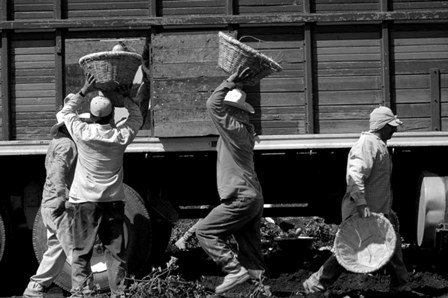
My first trip to rural Mexico was in 2003. I spent three weeks in remote villages in the Sierra Juarez of Oaxaca and in villages around Cuetzalan, Puebla. One night in San José Tenango, a small village in the Sierra Juárez, I asked a young man what he thought would happen to el campo. Without hesitation, he answered, “No hay nada en el campo. Está perdido.” (“There is nothing in el campo. It is lost.”) I returned for five weeks in 2008, spending time in eleven villages spread across four states. If “lost” described el campo in 2003, the best word to describe it in 2008 might be “dying.”
My first stop was San Augustín in Morelos, where I stayed with Efrén Enriquez Elizalde and his family, who grow nopal, an edible cactus, on about two-and-a-half acres. Harvest season extends from July through February, and during those months Efrén, his son Cristobal, and Cristobal’s father-in-law are in the field shortly after daybreak three days a week. Zenaida, Efrén’s wife, prepares breakfast at home before joining them. After eating their breakfast in the shade of their truck, the four begin their work. They harvest under a punishing sun for eight to ten hours a day, cutting the nopal with a knife. “This is very hard for the hands,” Zenaida told me. The nopal is collected in baskets that weigh seventy pounds apiece when full.
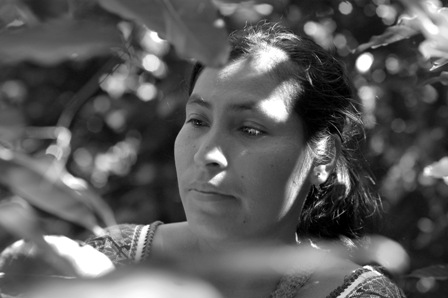
I tried to ask Efrén how much he earns in a year. I asked him several times and in different ways. Finally, he admitted he didn’t know. Most campesinos earn about $600 a year from their produce; Efrén earns a few hundred more from the construction jobs he picks up in nearby villages. He sometimes works as a jornalero—a day laborer—for other growers, who pay him about $10 a day. “I really only earn enough to survive,” he told me. I heard that many times on my trip.
My next stop was Villaflores, a village in Tabasco, where a lot of cacao is grown. Cacao has been grown and consumed in Mexico since at least 1100 BC. It grows especially well in warm, humid regions like Tabasco. The whole time I was there, my clothes were soaked with sweat. I was surprised to learn from a resident of Villaflores that it was the cool season.
What we call chocolate begins in small, tapered pods that grow on trees. In November, the pods ripen and turn yellow. Workers use a wooden pole to knock down the pods and a machete to cut them open, exposing seeds covered with a white milky substance. The seeds are what will eventually be turned into chocolate. After the seeds are removed from the pods, they are scooped into bags that weigh just over a hundred pounds when full. Two, sometimes three bags are loaded onto utility tricycles and taken to the cacao warehouse in Huimanguillo, a small city about five miles away.
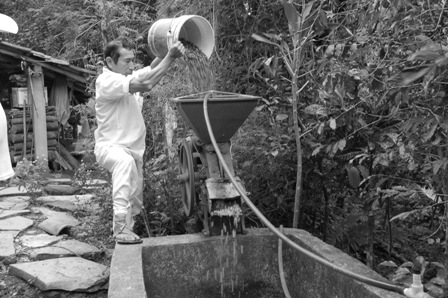
Tabasco, like many other cacao-producing areas in Latin America, has recently been hit with a fungus that has destroyed 80 percent of its harvest. The fungus has forced many campesinos off their land. “The reality is that cacao is disappearing,” said Esteban Elias Álvarez, president of the Association of Local Agricultural Producers of Cacao in Huimanguillo. “There really is no work in el campo when there is no cacao.” Those who stay have started planting other crops, like banana and pineapple, but they will have to wait several years for the trees to mature and produce fruit. “Life in el campo is changing, but it’s not easy for people here to change to new ideas,” said Arnufo Cruz Ramos, the president of the Villaflores cacao growers. “They’re conservative.”
The association’s warehouse in Huimanguillo is a dark, musty building. All day during the harvest, campesinos trickle in with their loads of cacao, which are weighed and then unloaded into large wooden crates where the cacao will ferment. Standing outside the warehouse, Álvarez talked about the brutal economic realities that campesinos are up against. “Most people have small farms, two hectares [about five acres] is the average,” he said, “and with only two hectares, it’s very hard to support a family, no matter what type of crop you have.” He told me the government sometimes subsidizes other crops, but not cacao. “Cacao is a luxury. People who have money eat chocolate. Campesinos don’t eat chocolate. It’s too expensive.”
Campesinos in the area around the beautiful village of Cuetzalan, Puebla, grow some of the world’s best coffee. Although coffee is not native to Mexico (it arrived sometime in the late 1700s), it took well to the high altitudes, rich soil, and humid conditions of the mountains of Puebla and southern Mexico.
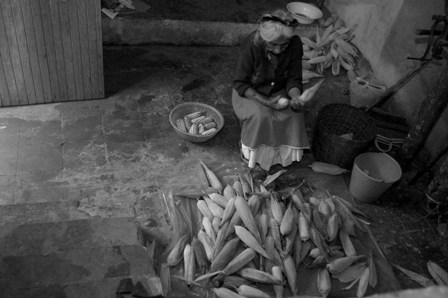
The coffee we drink starts out as a double seed (or bean) inside a small pod that turns bright red when it’s ripe. In Puebla, the coffee harvest happens between November and February. Like almost all work done by campesinos, the harvest work is done by hand. “On a good day, you can pick maybe thirty kilos [sixty-six pounds],” said Francisco Salazar, who grows coffee on about five acres. “In cooler weather, the fingers are stiff and you pick less, maybe fifteen.” After the coffee is picked, it is bagged and carried to the campesinos’ houses, where it is washed and passed through a machine that separates the fleshy outer part from the beans. The beans are then raked out on a roof, where the sun dries them to a golden color (the dried beans are called café oro). Once it is dry, the coffee is bagged and taken to a warehouse in Cuetzalan. I asked Francisco Diego Petra how he got the coffee to Cuetzalan. “By bus,” he replied. And how did he get the bags to the bus? He smiled and tapped his back.
Coffee prices dropped precipitously in the 1990s and have remained low ever since. Before this drop, Candido Morelos Diaz, a campesino who was my guide in San José Tenango, earned $1.50 a pound for his coffee. “This was a good price,” he told me. “I could live well. I could buy rice, bread, clothes, and shoes.” Prices on the world market often fluctuate wildly, and when I spoke with Candido, he was earning around fifty cents a pound for his coffee. “Right now I cannot afford socks and do not have any,” he said, lifting a pant leg to show me. “The clothes I have now were a gift. The shoes were a gift, too.”
Most campesinos living near Cuetzalan belong to the fair-trade cooperative Tosepan Titataniske—a Nahuatl phrase that means “together we will overcome.” Fair-trade cooperatives pay campesinos a higher, guaranteed price for their goods. The guarantee protects campesinos from market fluctuations and gives them a better idea of what they will earn in a given season. Because coffee prices remain low, Tosepan is encouraging campesinos to diversify their crops. Some have begun cultivating bamboo, honey, and black pepper, which grows wild in the area.
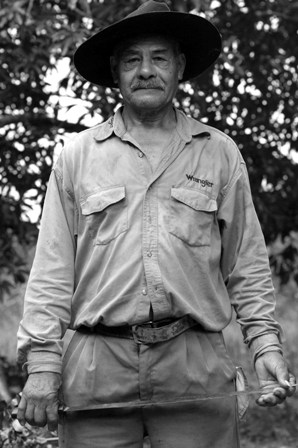
Muriel Calo and Timothy Wise of Tufts University have found that fair-trade cooperatives can double a campesino’s income, but this still amounts to only about $1,200 a year, far less than a campesino needs. “The extra money improves their lives a little bit,” said Efrain Martínez Bautista, who is president of Tosepan Titataniske. “Maybe they do not leave for the city. But we also offer services like low-interest loans, projects on how to increase production, how to produce honey.” Tosepan Titataniske also promotes sustainable agriculture and organic farming, and it has built an ecotourism site just outside of Cuetzalan.
Veracruz used to be the center of Mexico’s vanilla-growing region. According to David Blas, director of the Mexican Vanilla Plantation, Mexico was once one of the world’s leading producers of high-quality vanilla. The Mexican Revolution put a serious dent in production and WWII almost ended it. Blas’s company, which is certified organic and fair trade, is trying to rebuild Mexico’s vanilla production but has had difficulty finding markets.
Vanilla is an orchid that needs trees or trellises on which to grow. It is pollinated by hand in April, and the flowers develop into long, slender green pods. The vanilla harvest traditionally takes place on December 10; on that day, hundreds of campesinos bring their vanilla to a warehouse in Túxpam. I planned my trip so that I would be in the vanilla-growing region on December 10, but the harvest was delayed. After I had spent two days in the village of Juana Moza, it was decided I should go to an ejido called Primero de Mayo, where the harvest was still scheduled to occur. Blas, who took me to the ejido, had to explain to the campesinos that, unfortunately, he could not buy their vanilla. He already had all he could use.
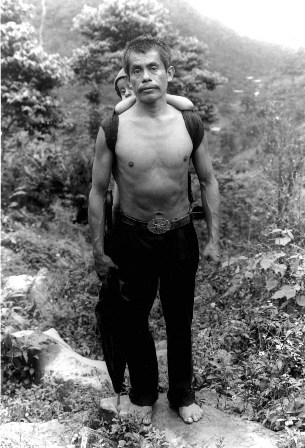
Campesinos in villages near Tuxpan also grow citrus, but in Primero de Mayo little is grown besides vanilla. There is talk of building an ecotourism site like the one near Cuetzalan, but nothing has come of it yet. I spent a couple of days in Primero de Mayo, but the harvest date kept getting pushed back. I finally decided not to wait any longer. Before leaving, I asked Basilio Juárez Santiago, president of the local vanilla growers, what the problem was. “There are no buyers,” he said. “What if there are never any buyers?” I asked. “Then,” he said, “we wait.”
In el campo, there is a lot of waiting. And a lot of worry. Campesinos in the Sierra Juarez often say “Nosotros sufrimos mucho” when they talk about their lives: “We suffer much.” Unless there is a radical change in Mexico’s agricultural policies, their suffering will continue.
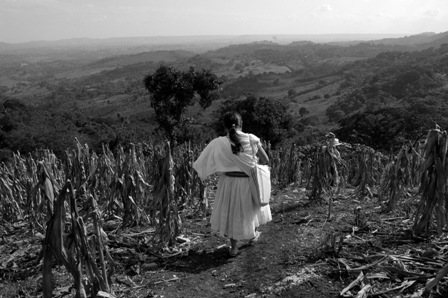
All photographs (c) 2008 Joseph Sorrentino
Related: Ananda Rose Robinson on ministering to immigrants along the Mexican border


